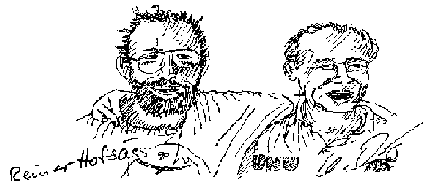Wakefield International Cup - A history from 1911 by Charles Dennis Rushing
1981 Lothar Doring, 27, FR Germany
Monday, August 10, 1981: This would be the Thirty-Fifth Wakefield Cup event since 1928. For the first time the contest would be held in Spain, at the village of Burgos. In the travel and tourist guides Burgos is described as "... a windy place..." Martyn Cowley railed about the meteorology of Burgos from the onset in his tirade for Aeromodeller, forgetting the Cranfield venues of years gone by. Martyn was unkind to the contest organizers also; he tweaked my interest when he mentioned "THE RULES". The aerodrome was itself fairly large, but it was bounded on two sides by industrial buildings and housing. The area was flat. The wind was a problem, and it left an undying impression on everyone in attendance. This wind came on every day at about noon, and apexed in the late evening, then blew all night. There must have been shutters slamming through the nights where Cowley slept, because the edge of sleeplessness was lying between his lines.
Not present to contribute to the cursing were the teams from (DDR) and (P). (B) was there, so was (D), (F), (CCCP), (N), (J), (4X), (I), (L), (OY), (ZK), (G), (PH), (SE), (YU), (LV), (C), (SP), and of course (EC). On a note of interest the 1953 Wakefield Champion Joe Foster came back to the WC, his first in ten years! The 1979 Wakefield WC Itzhak Ben Itzhak of Israel was on hand to defend his title. In all there were thirty-one nations present to compete in this environment, and promptly half an hour late at 7:30am could be heard the winder gears of eighty-one very determined contestants.
ROUND 1: The rocket announced the beginning of the round, and now the whirring sound from the winders became an epidemic. Victor Roshnok (CCCP) was the first one up, giving the world its first look at a DPR launch at the WC. All of Team CCCP were equipped with these new machined aluminum front end devices. First the propeller blades were locked into a full feathered position, then after winding the rubber motor the front end is hooked on, after wind-up, while waiting for the signal to launch from the Team Manager, winds can be added through a ratchet stop device. At the order to launch, a thumb stop release triggers the timer, which releases the propeller hub at 0.7 seconds. The propeller now rotates either to a pre-set pitch. If it has variable pitch it rotates through a series of pitch positions. The F1B is simply launched like a javelin, achieving a bonus height of from 10 to 30 feet, depending on how athletic the person doing the launching is. Other bonus from this method is that when the aeromodel is launched it assumes a more consistent flight position, and no winds are lost on the launch. The WC contest for the best javelin launch was between Eugene Gorban, and his Teammate Aleksanar Andrjukov. As the round ended only two teams had maximum scores (N), and (LV).
ROUND 2: The wind increased, and a layer moved in lessening the lift. This round closed with twenty-one having two maximum scores.
ROUND 3:Thermal detection used to be simple, one simply felt the rise in temperature on their skin. Not so any more, thermal detection devices were now assuming scientific instrument levels. When first introduced there was a great deal of consternation about the legality of use of such instruments, these devices were banned from the launch zone at the 1977 WC, by official proclamation. Now it was truly difficult to compete without one.
ROUND 4: The Israeli Team misread their twin recording thermal detectors, which had been unfailing at Taft, here Ben Itzhak dropped the round.
ROUND 5: Upwind the Japanese placed 400 small kites next to the twelve thirty foot high poles topped with long colorful silk ribbons placed by the Team China. This maze did not go unnoticed by Joe Foster, who also had his own recording thermal detector, because he maxed the round again. The contest organization broke down in this round when no signal was given to close the round.
ROUND 6: Now the organizers failed to provide a signal to open this round! The French Team was especially shaken by this screw-up, because they had two team members with perfect scores up until now. Joe Foster was down in only 142 seconds. Only Doring (D), Landeau (F), and Pierre-Bes (F) had perfect scores now.
ROUND 7: The German Democratic Republic Team was refreshing in that they shunned wearing Nationalistic clothing, had no dictatorial Team Manager issuing orders to launch, you were "...on your own like a rolling stone. In the great unknown". This was Lothar Doring, using his twin recording devices to measure wind speed and temperature differences on a paper print out. The sensing devices were located 500 yards up wind and Lothar determined his own destiny. Holding now for 10 minutes with a fully wound motor, he decided to switch to a preloaded aluminum motor tube. Now he quickly set up the fresh fuselage on his winding stand and cranked in 360 turns into a 16 strand Pirelli motor, all the while watching his meteorology instruments. Slowly there came a lull in the wind speed, and a rise in the temperature, as a thermal of some consequence moved towards him, upwind. Lothar was ready having practiced this condition hundreds of times. He launched at the in-filling wind, and maxed the round. Let the Contest begin! The Frenchmen using similar techniques both maxed the round. There will be a fly-off today.
ROUND 8: This would be the 240 second round, beginning at 7:03pm. Lothar began winding his number one "Espada" just after the horn sounded to start the round. After he had put in 360 turns, he set this one aside, and set up his spare aeromodel on the stand, but did not wind it up. Now Lothar set himself to the task of reading his meteorological instruments with intensity. The launch window clock was ticking, five minutes had already passed in the fifteen minutes allowed. Lothar convinced of the lift indicators from his instruments, picked up his already wound "Espada", and javelin launched it straight up. His Wakefield trembled in the climb, going straight until the initial torque came out of the rubber, than right, and continued that way throughout the glide. Gerard had followed Lothar and Alain followed him. Lothar maxed, then Gerard, then Alain. There would be another fly-off round.

Lothar DoringROUND 9: This would be a 300 second round, and it began with an impound for processing, after all three F1B had been retrieved from the industrial area. There was a problem! LOTHARS RUBBER WAS OVER THE 40 GRAM LIMIT! French for "bitching" is "bitching", and it was loud, and it was clear that they were very unhappy. A comparison of the weight scales indicated the scales were not coordinated. A line was finely drawn in the sand, the start of the next fly-off round was set for 7:45pm. Lothar again set up his "Espada", but this time as he stretched the motor it lurched in the stand, and broke the tail boom! Alain had meanwhile tripped over his winding stand, but he got up smiling. Yes, tension was building. Gerard launched first. Lothar watched Gerard's F1B, and his instruments, and than he launched. At three minutes before the round ended Alain went off. Gerard was down first, 126 seconds, than down came Alain, 190 seconds. Lothar Doring's Wakefield was still very high over the industrial area when it DTed at 300 seconds, today he would be the 1981 Wakefield World Champion!
A final, painful incident occurred after the contest when Lothar Doring was at a hotel party, the celebration prompted one of the Spaniards to call the Carbenari to curb the jubilance. One of the police officers struck Lothar in the left knee, with a rifle butt, causing cartilage damage, from which he never recovered. So much for "...friendly International competition"!
| Place | Name | Country | Round 1-7 | Round 8 | Round 9 |
| 1 | L Doring | BRD | 1260 | 240 | 300 |
| 2 | A Landeau | FRA | 1260 | 240 | 190 |
| 3 | G Pierre-Bes | FRA | 1260 | 240 | 126 |
| 4 | E Gorban | CCCP | 1257 | ||
| 5 | W Ghio | USA | 1242 | ||
| 6 | M Kobori | JPN | 1240 | ||
| 7 | I Ben Itzhak (1979 WC) | ISR | 1226 | ||
| 8 | J Foster (1953 WC) | USA | 1222 | ||
| 9 | L Balzarini | ITA | 1221 | ||
| 10 | L Dupuis | FRA | 1204 |
| 1981 Team Results for Penaud Cup | ||||||
| Place | Country | Abbreviation | Total | Team member places | ||
| 1 | France | FRA | 3724 | 2 | 3 | 10 |
| 2 | China | CHN | 3532 | 14 | 16 | 25 |
| 3 | Netherlands | NED | 3512 | 18 | 19 | 25 |
| 4 | Fed.Rep.Germany | BRD | 3502 | 1 | 23 | 41 |
| 5 | Japan | JPN | 3444 | 6 | 31 | 39 |
| 6 | USA | USA | 3442 | 5 | 8 | 62 |


References
Aeromodeller, March 1981, Wakefield (F1B) Technology, Martyn Cowley
Aeromodeller, Nov 1981, FF WC, Martyn Cowley
Aeromodeller, Jan 1986, FFWC Martyn Cowley
Music: "Breaking Away"; Literature: "Midnight's Children"; Cine: "Reds"; Alfred Hitchcock dead

